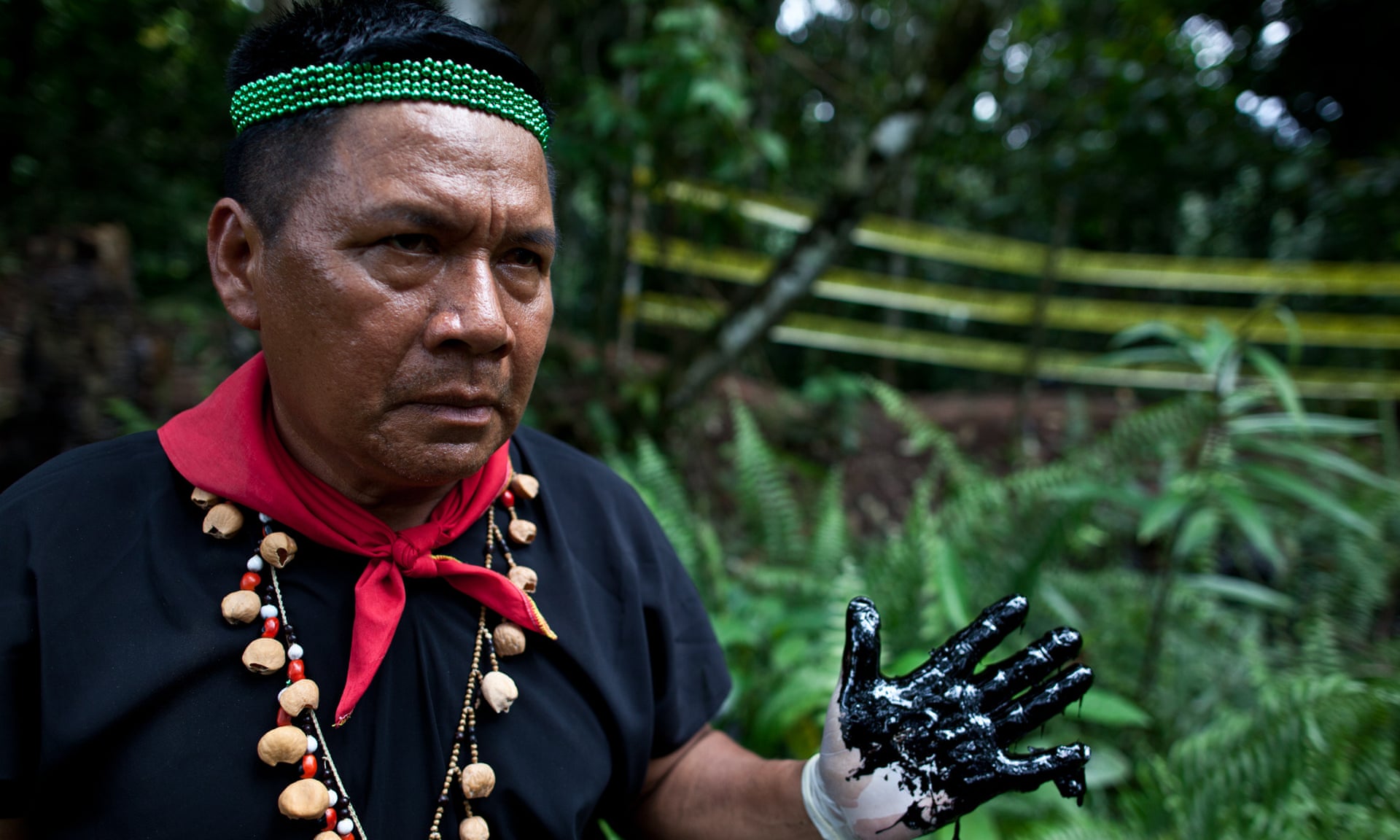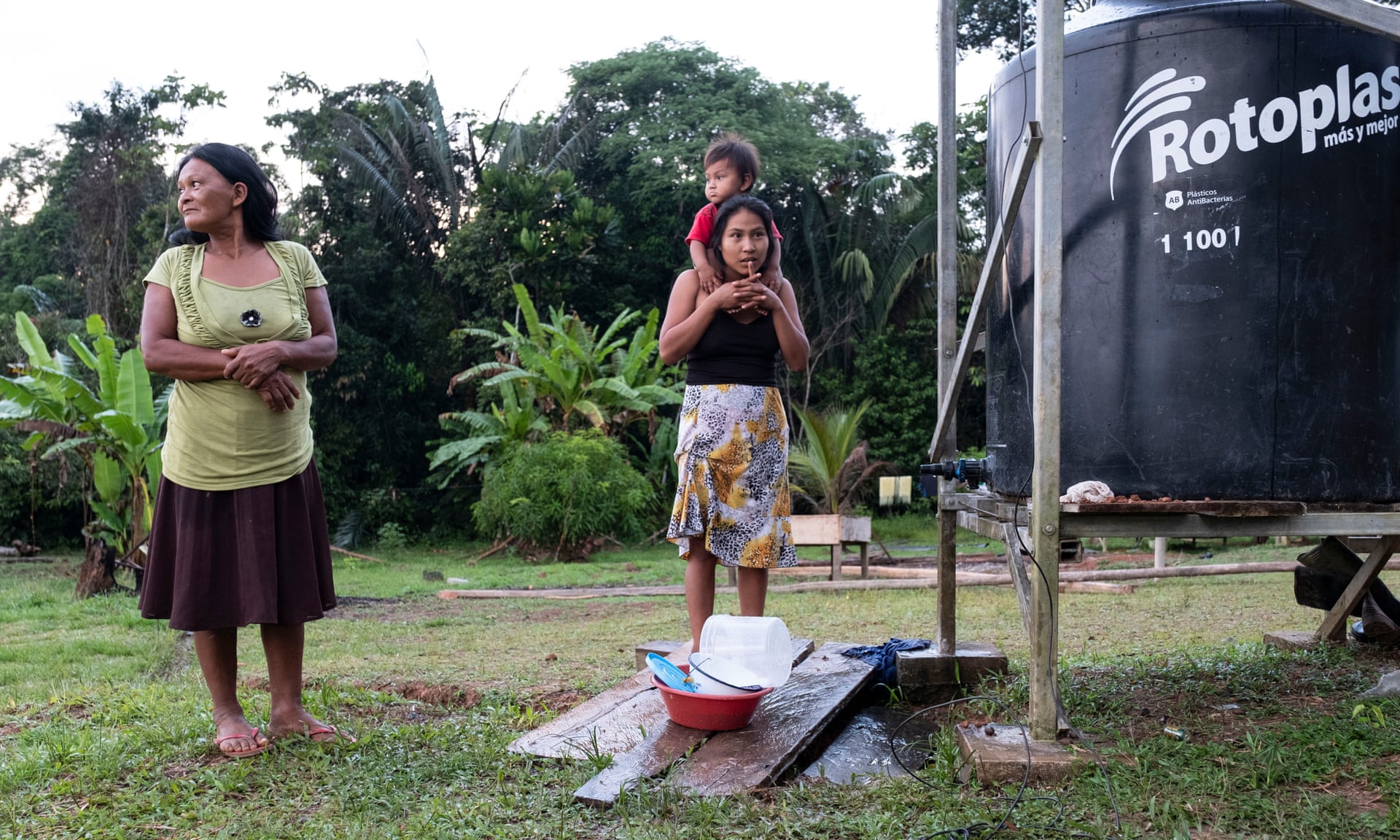
Scheme provides clean water and helps foster trust between indigenous groups.
By David Hill
March 24, 2020.- Romelia Mendúa was handing out plantain drinks served in aluminium bowls. Guests were seated in a hammock and on the bare wooden floor. Beyond the window was the lush vegetation of Ecuador’s north-eastern Amazon.
Chocula, as the drink is called, is made by mashing plantains into water, and is a common refreshment in the Amazon. But the water in Mendúa’s chocula was no ordinary water. It came through a tap in her kitchen connected to two tanks outside collecting and filtering rainfall.
“The tanks were installed three years ago,” said Mendúa, an indigenous Kofan. “I use them every day – for drinking, cooking, washing the pots and pans.”
More than 6,000 people in almost 80 villages stretching across 5m acres of the Ecuadorian, Colombian and Peruvian Amazon now have similar tanks. The area includes the ancestral territories of the Secoya, Siona and Waorani indigenous peoples, as well as the Kofan.
The first tanks were installed in 2012 and Mendúa’s village, Baborei, was one of the first to benefit. One of her neighbours, José Criollo, said: “When it’s raining, we use them a lot. Sometimes if there’s been two weeks of sun we can’t use them and so we borrow from other families who don’t drink much.”
Criollo said the water from the tanks was for drinking, cooking and washing up – but never for laundry or bathing. “There’s the Aguarico River or Baborei creek for that,” he said.
Sixty years ago the Kofan had no need to collect rainfall, given the Amazon’s many rivers, streams, creeks and springs. But then oil companies arrived. After decades of operations involving billions of gallons of wastewater being dumped into the environment and millions of barrels of oil spilled, Ecuador’s north-east Amazon has undergone an environmental catastrophe.
Mendúa’s husband, Emergildo Criollo, claims his two sons died from the contamination. “Everything totally changed when the companies arrived,” he said.
The impacts on the Kofan and other indigenous peoples in the region are impossible to convey. Swathes of their territories have been colonised, forest cleared, game and other wildlife decimated and fish, soil and water sources contaminated. The result has been a decades-long public health crisis affecting tens of thousands of people, including high cancer rates, spontaneous miscarriages, childhood leukaemia and birth defects.

Lasteña Criollo, another Baborei resident, said her father remembered the first big spill in the Aguarico in the 1970s. “The fish smelled of oil,” she said. “We ate it anyway. We knew it was wrong. Various people became ill.” Lasteña and her family do not drink from the river any more.
The tanks’ installation in Baborei and elsewhere has been overseen by the ClearWater project, a collaboration between various groups aiming to provide clean water to indigenous people. The Kofan and others have been trained to manage budgets and install and maintain the tanks themselves.
“My son Ermel was one of the first to be trained,” said José Criollo. “My other son Ignacio has helped install the tanks in other communities.”
This approach has helped foster cooperation and trust between the different indigenous peoples. Out of it has emerged the Ceibo Alliance, a non-profit organisation made up of Kofan, Secoya, Siona and Waorani, which is partnering with the NGO Amazon Frontlines.
“We had to look for a better way to organise ourselves and fight,” said Hernán Payaguaye, a Secoya man and Ceibo director. “Working together makes us stronger.”
Over the years the technology in the tanks has evolved. In most cases, rainwater runs from rooftop gutter spouts into a 300-gallon tank with a four-layer bio-sand filter that cleans the water, and then into a second 300-gallon tank where it is stored for use. The filter removes bacteria, kills microbes, breaks down other incoming organic material and traps contaminants including toxic metals and oil pollution.

“When the traditional sources of drinking water have been poisoned, the best, most creative alternative is to capture and filter the rain of the rainforest,” said ClearWater’s founder, Mitch Anderson.
Anderson said the idea for the tanks mainly emerged from anger and frustration at the failure of almost two decades of legal action to benefit local people. After a US court ruled that a class-action lawsuit filed in 1993 against Texaco should be heard in Ecuador, the case was effectively refiled 10 years later against Chevron, which had acquired Texaco in 2001.
In 2011 an Ecuadorian court ruled that the company should pay more than US$9bn, but Chevron, which has aways denied being responsible for any environmental contamination in the country, appealed. In 2018 a tribunal administered by the permanent court of arbitration in The Hague ruled that parts of the 2011 judgment were obtained through fraud, bribery and corruption, and that it should not be enforced in Ecuador or anywhere in the world.
“After two decades of demanding justice with little direct results for the impacted communities, people said: ‘We can build justice ourselves,’” Anderson said. “The first step was ensuring all families have clean water.”
In 2011 Anderson, together with Emergildo Criollo, who became ClearWater’s project director, visited dozens of indigenous villages affected by oil operations. “We asked them: ‘What do you need most?’” Criollo said. “The reply: clean water.”

Añadir nuevo comentario